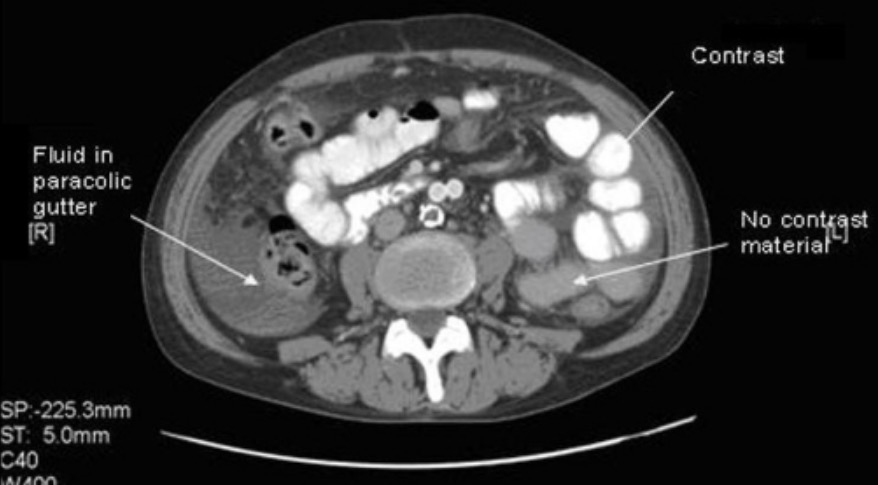Playlist
Show Playlist
Hide Playlist
Negative and Positive CT: Spinal Cord Injury
-
Emergency Medicine C-Spine Injury.pdf
-
Download Lecture Overview
00:01 Bottom-line is that we have wonderful decision tools to help us make intelligent decisions about whether or not to get a CT. 00:08 If we do decide that we're gonna go ahead and get a neck CT, and that scan is negative, we still need to interpret our scan result in the context of the patient's presentation. 00:22 So if I get a negative CT, and I'm surprised that it's negative, because I'm really worried about this patient. 00:28 I think they have a lot of pain, I think they actually have a neurologic deficit. 00:32 I wanna emphasize that CT is not perfect, so if I have concerns, I'm gonna maintain their spine immobilization, and I'm gonna move on to MRI. 00:42 Now, that's a relatively small subset of patients. 00:44 But I do wanna emphasize that a negative CT is not the same as a clean bill of health. 00:49 If I don't have major concerns about the patient and their scan is negative. 00:55 I'm gonna go ahead and take off their collar. 00:57 I'm gonna provide them with symptomatic treatment. 01:00 The mainstay of treatment is gonna be nonsteroidal anti-inflammatory drugs, but I might consider muscle relaxer as an adjunct as well. 01:07 I'm gonna discourage them from lying around in bed, and using those soft collars that you see on TV in a lawsuit dramas, because they're not actually beneficial. 01:17 The collars and bed rest really just delay healing, they weaken the muscles around the spine, and they make it harder for the body to mend itself. 01:27 So we wanna keep patients up and engage in their normal activities, and supporting their heads on their own. 01:34 They can return to work or to athletic participation if that was a source of their injury once their symptoms are resolved. 01:41 If they have a positive CT, obviously, I now have confirmation that they have a significant spine trauma, and I'm gonna need to address that accordingly. 01:51 So the first thing I'm gonna do is make sure that I maintain high quality spinal immobilization. 01:56 Now, those collars that the paramedics put on, they're pretty uncomfortable and they don't always work that well to maintain immobilization because they don't always fit the patients great. 02:06 So we wanna switch over to a padded more fitted, long-term collar. 02:10 The type we use in the US is called the "Miami-J." There are different products on the market though, and the bottom-line is you want something that's gonna fit well. 02:18 That's gonna be comfortable for the patient, and it's gonna really hold their neck in the proper position. 02:23 If the CT is positive, we wanna definitely get our spine surgery colleagues involved, that might be orthopedic spine versus neurosurgery, depending on your institutional protocols. 02:35 At my institution, we involve ortho spine for patients who are neurologically intact, and neurosurgery for patients who have deficits. 02:44 Usually, every patient with a positive CT is gonna get an MRI to better evaluate the soft tissue structures and identify if there is any spine or nerve root injury, and of course these patients are gonna be in pain. 02:57 So they are gonna need symptomatic treatment to control that. 03:00 So the bottom-line on spine injury is that it's a very, very common problem that you're gonna see a lot in Emergency Medicine. 03:07 But serious spine injury is quite rare, but very devastating when it does occur, and we don't wanna miss cases of that. 03:16 Fortunately, we have evidence based validated decision rules that allows us to make good decisions about who can be cleared clinically versus who needs a CT scan to look for potential injury, and our options there are either the NEXUS Criteria or the Canadian C-spine rules as we discussed and we're gonna image all patients who can't be clinically cleared. 03:38 Thank you.
About the Lecture
The lecture Negative and Positive CT: Spinal Cord Injury by Julianna Jung, MD, FACEP is from the course Trauma (Emergency Medicine).
Included Quiz Questions
Which of the following should be recommended to a stable patient without any neurological deficit whose CT scan is negative?
- Return to work when symptoms are resolved.
- Avoid nonsteroidal anti-inflammatory analgesics.
- Maintain bed rest for 5-7 days.
- Use soft collars to decrease the strain on cervical muscles.
Which of the following is the best option for the management of a patient with a suspected spinal injury whose CT scan is positive?
- Spine surgery consultation
- Bed rest for 2-3 weeks
- Supportive treatment alone
- Order a DEXA scan to screen for osteoporosis
Customer reviews
5,0 of 5 stars
| 5 Stars |
|
2 |
| 4 Stars |
|
0 |
| 3 Stars |
|
0 |
| 2 Stars |
|
0 |
| 1 Star |
|
0 |
Fluent in her speech and adds her own experiences. It's effortless and clear. A lecture series I can listen for fun and not only for my studies.
Probably the best teacher I have watched on Lecturio. Thank you so much!




